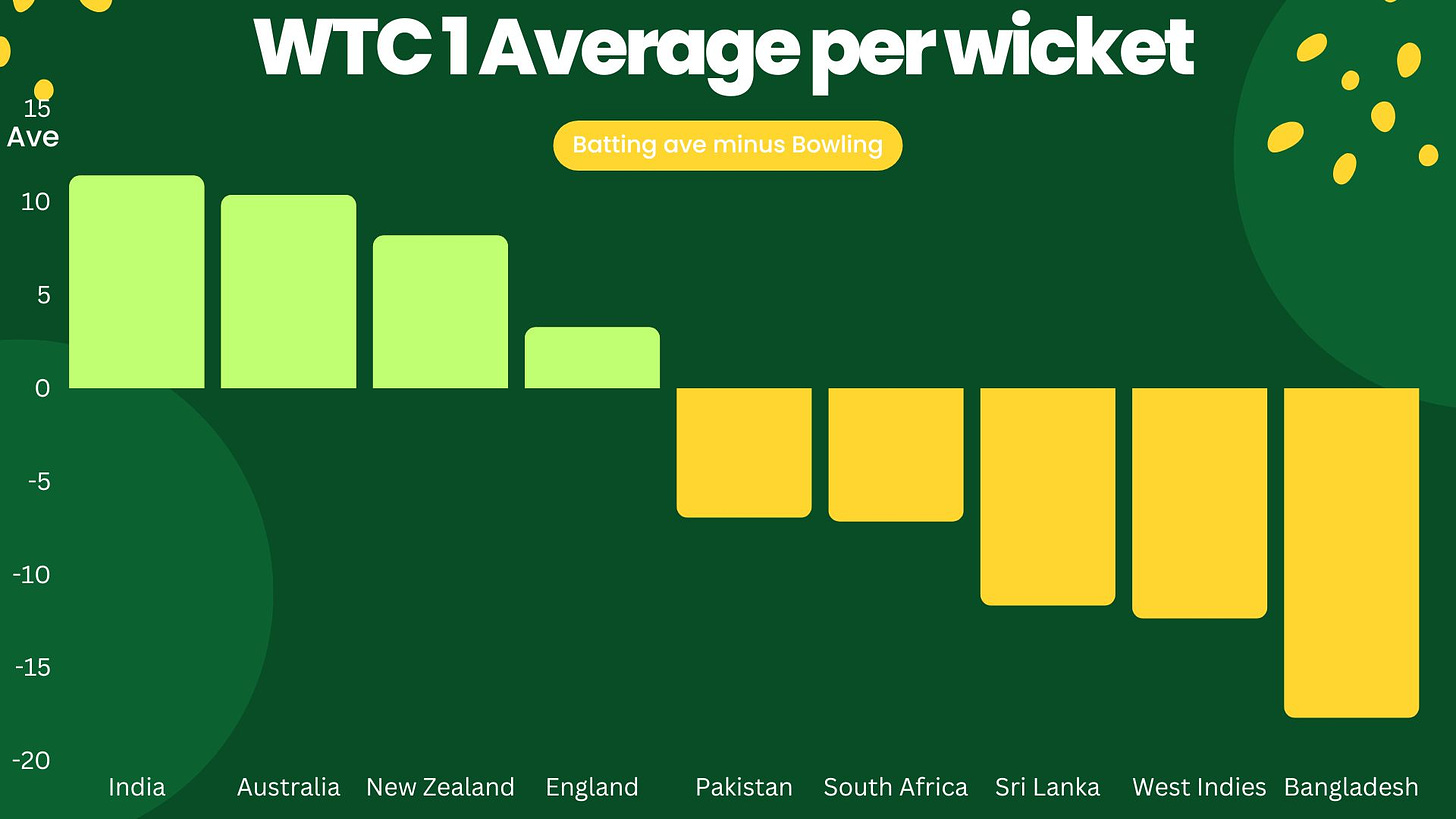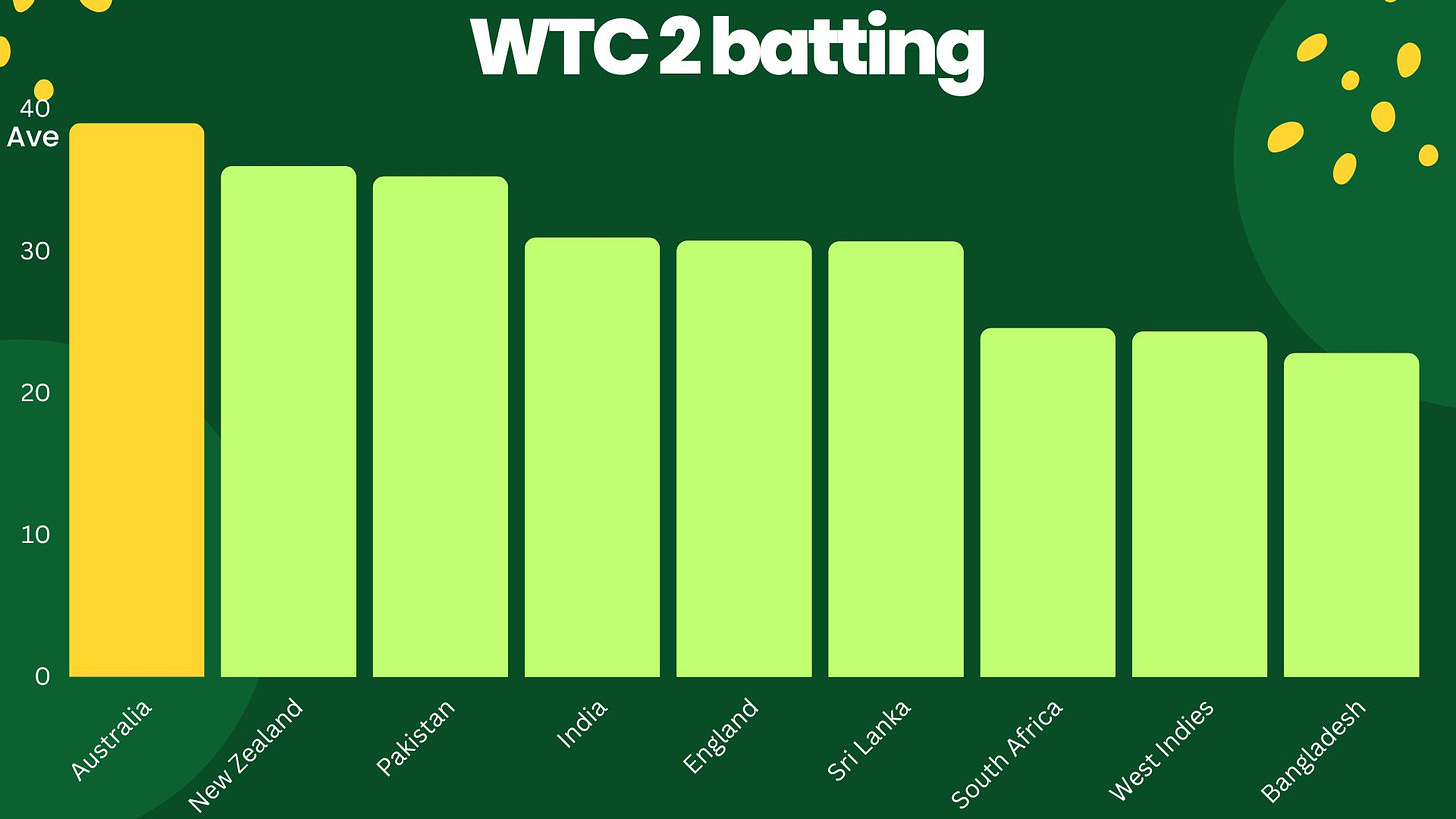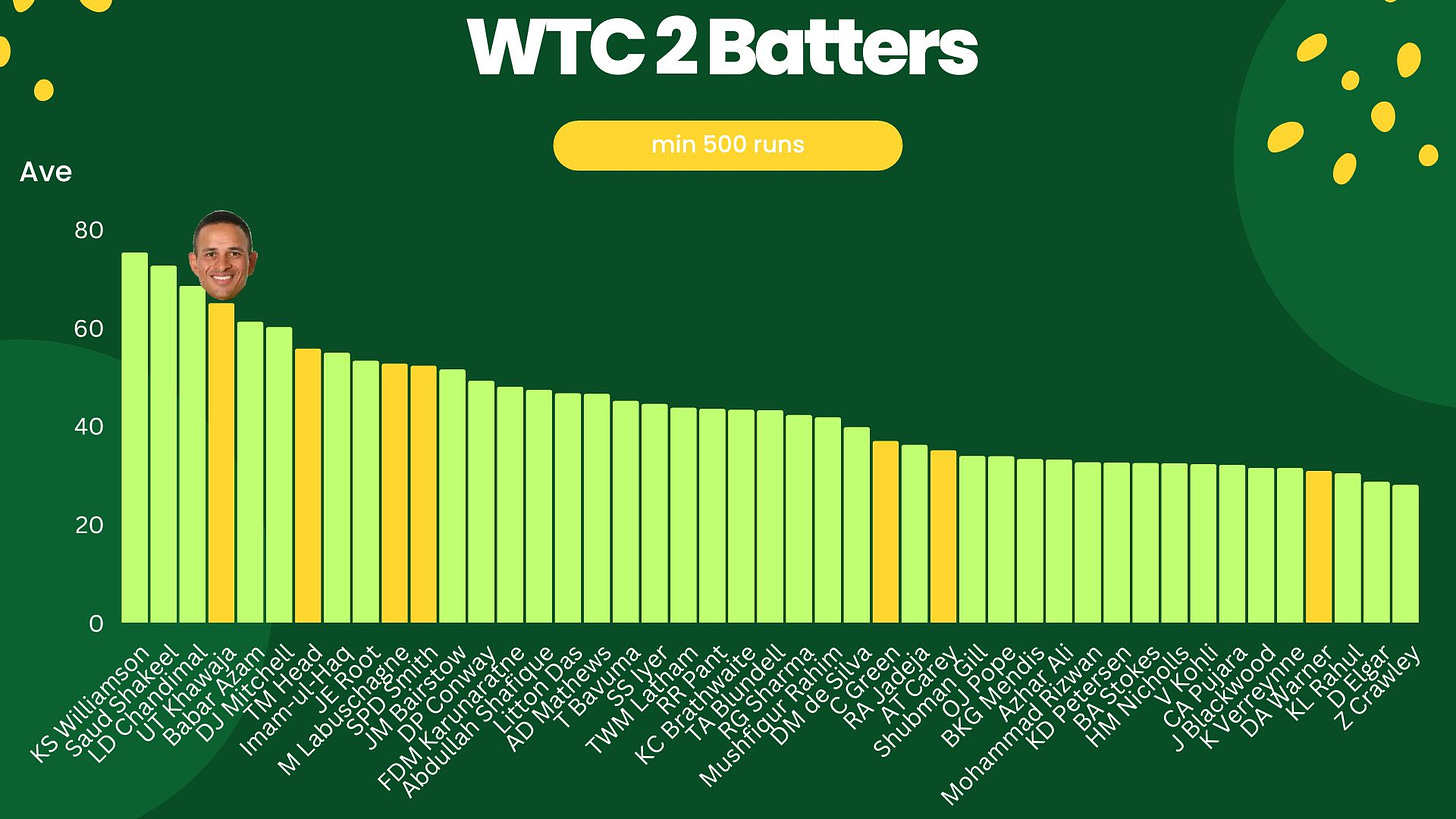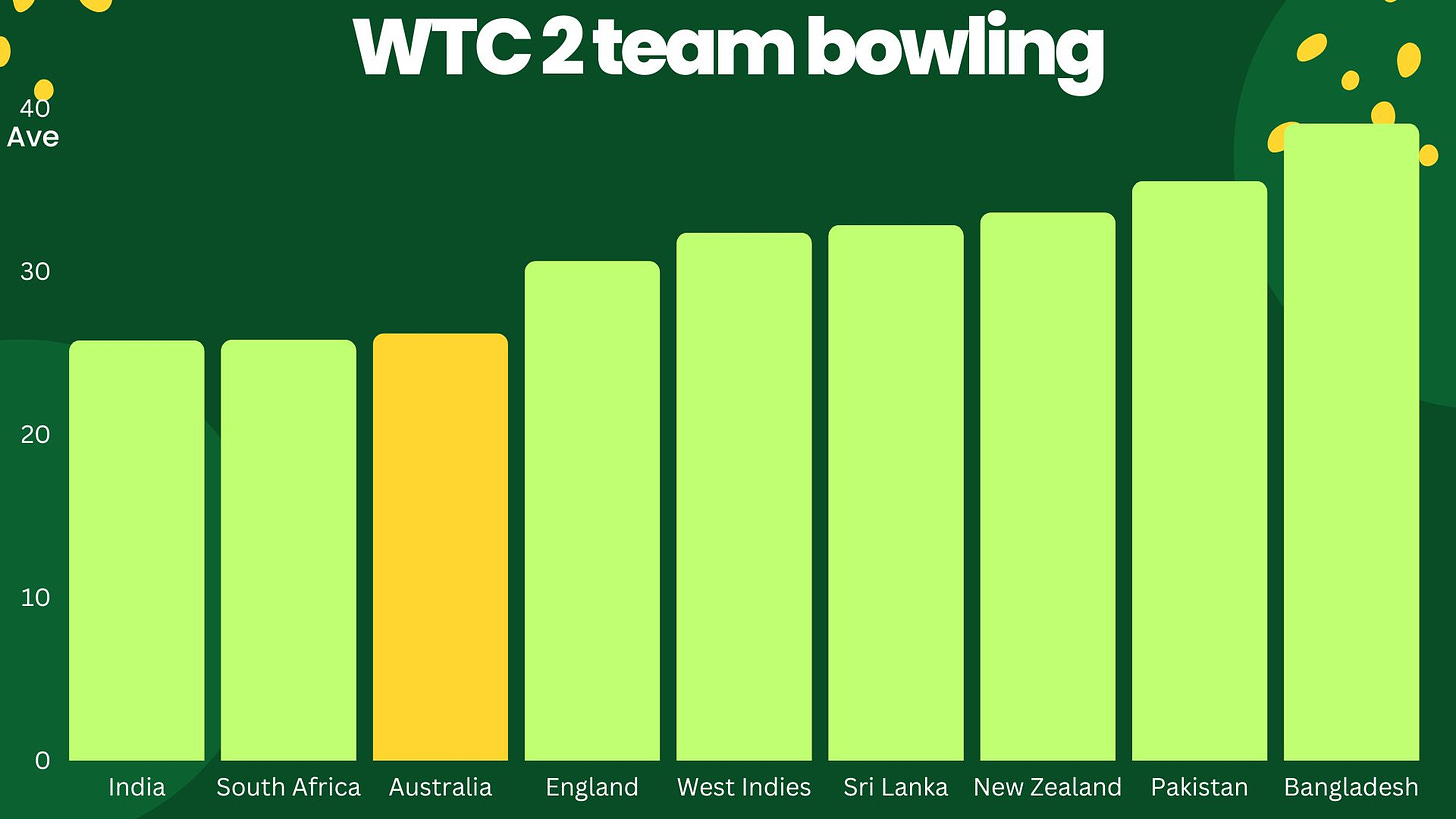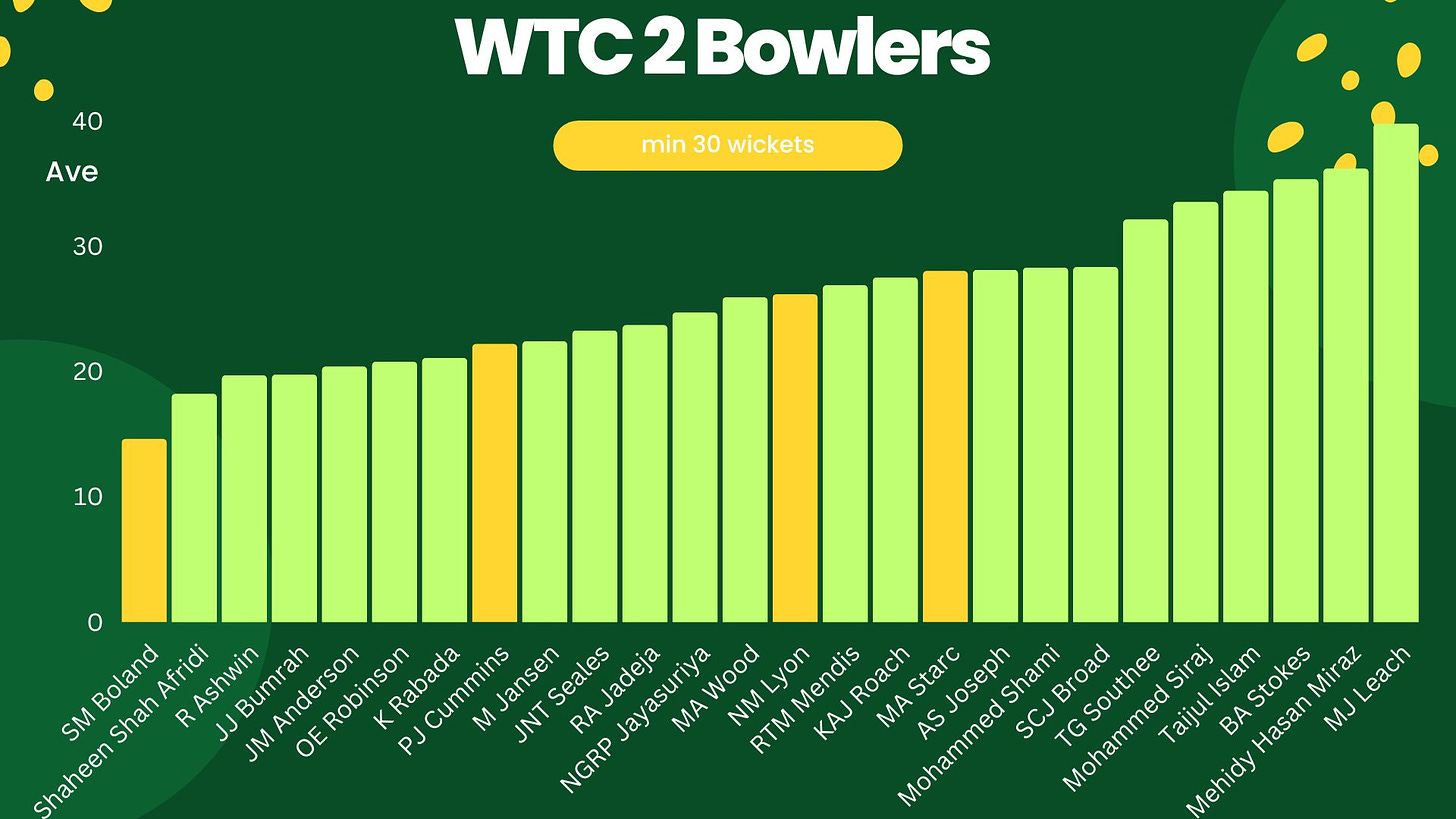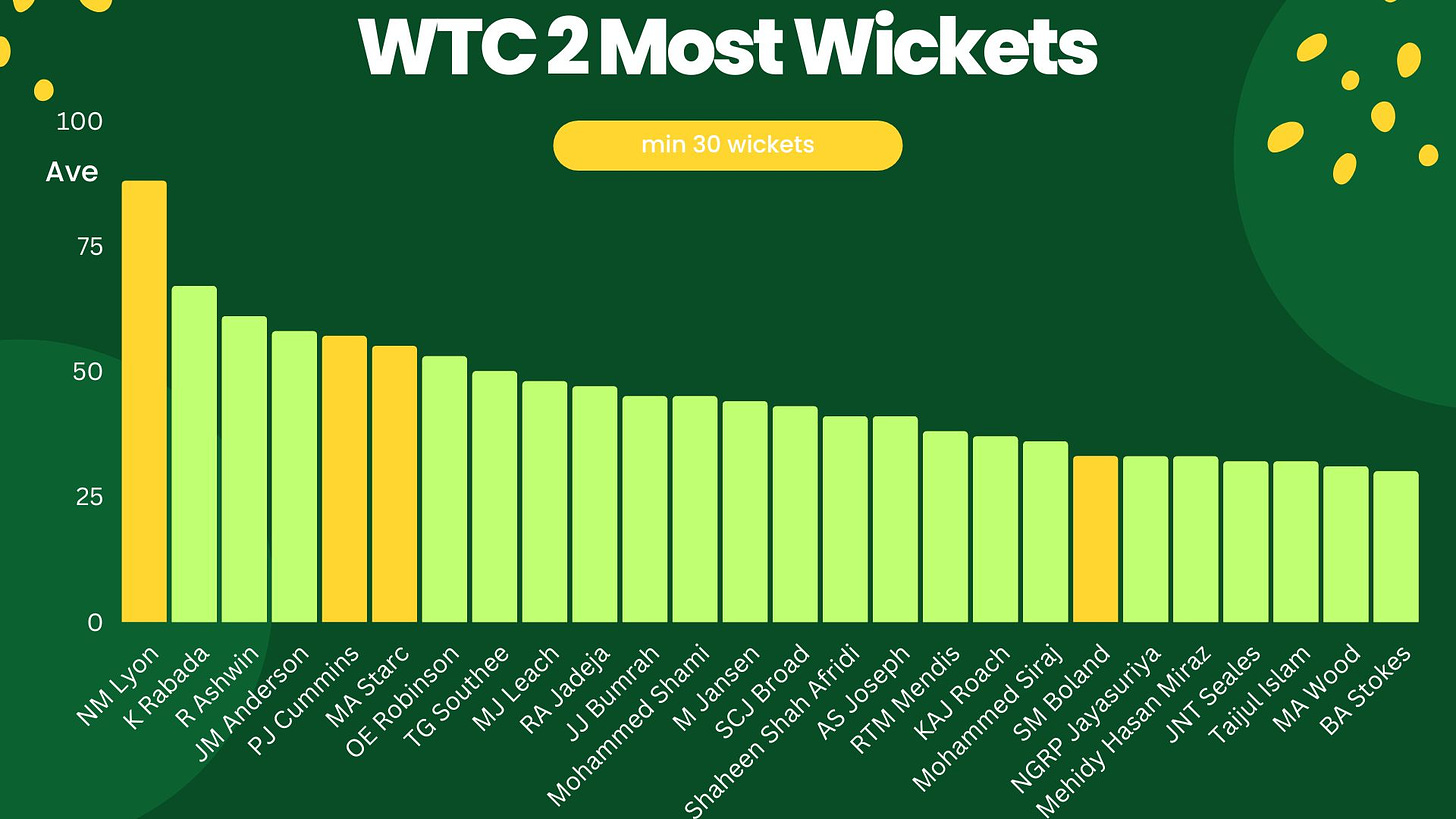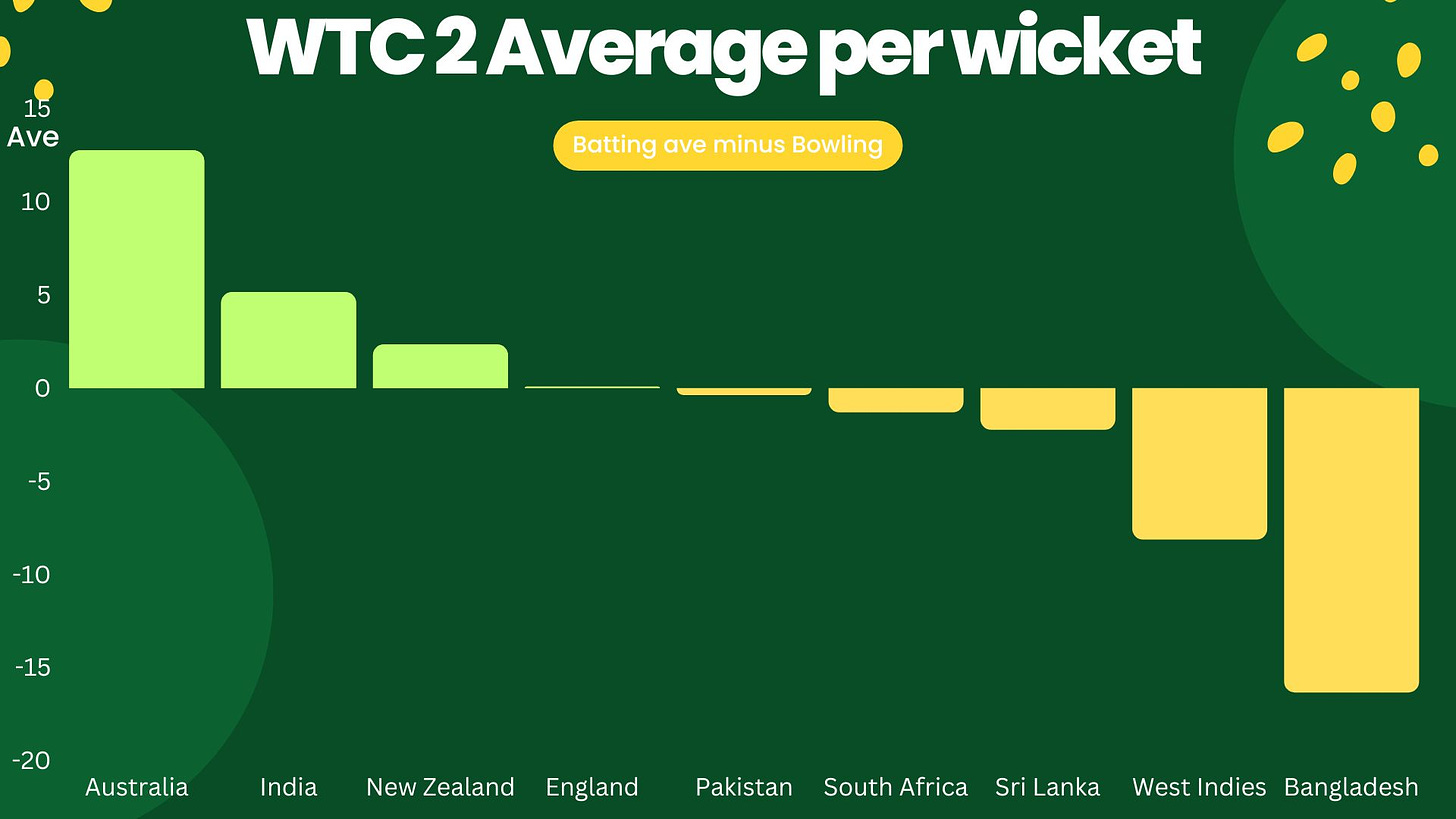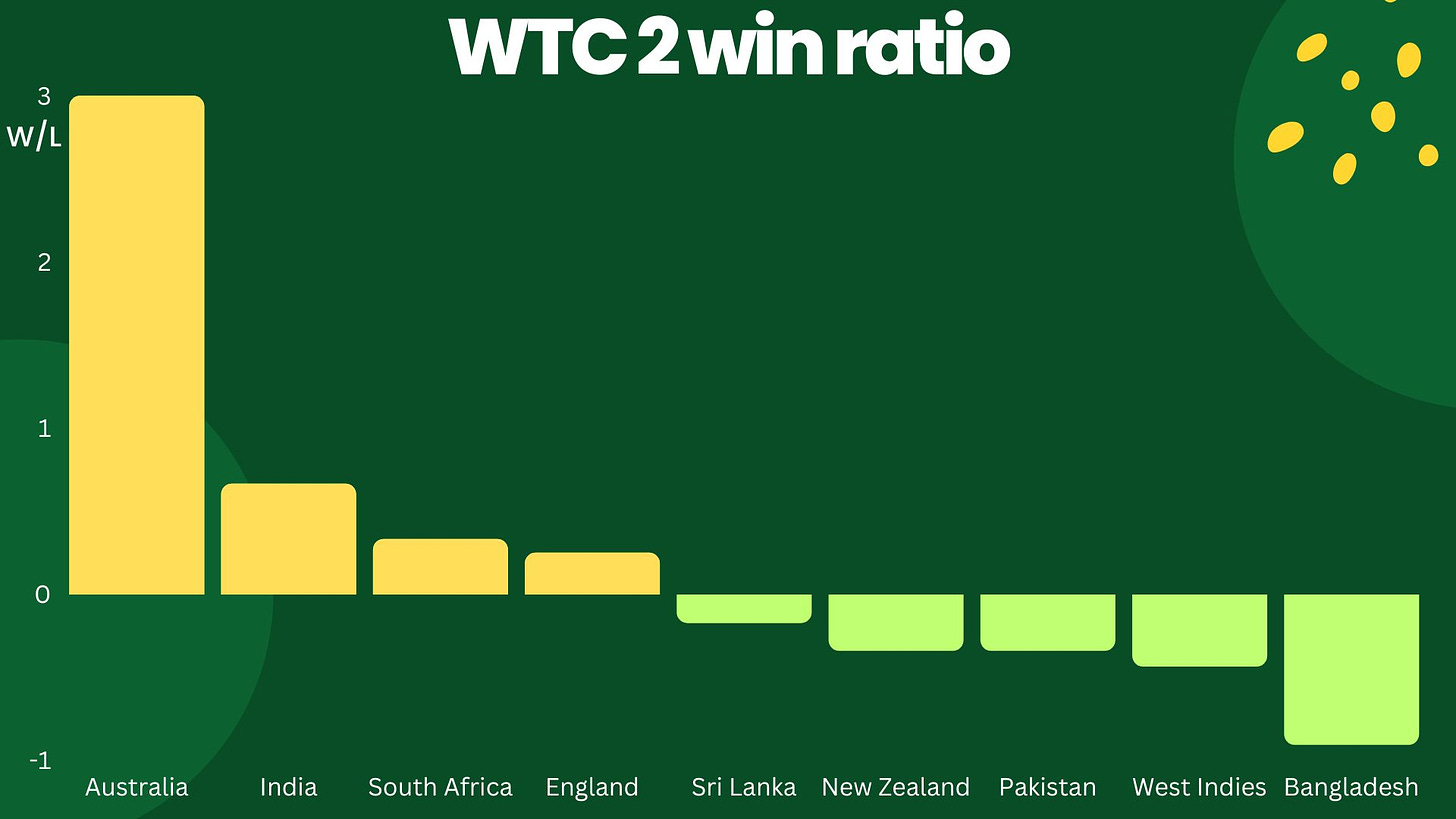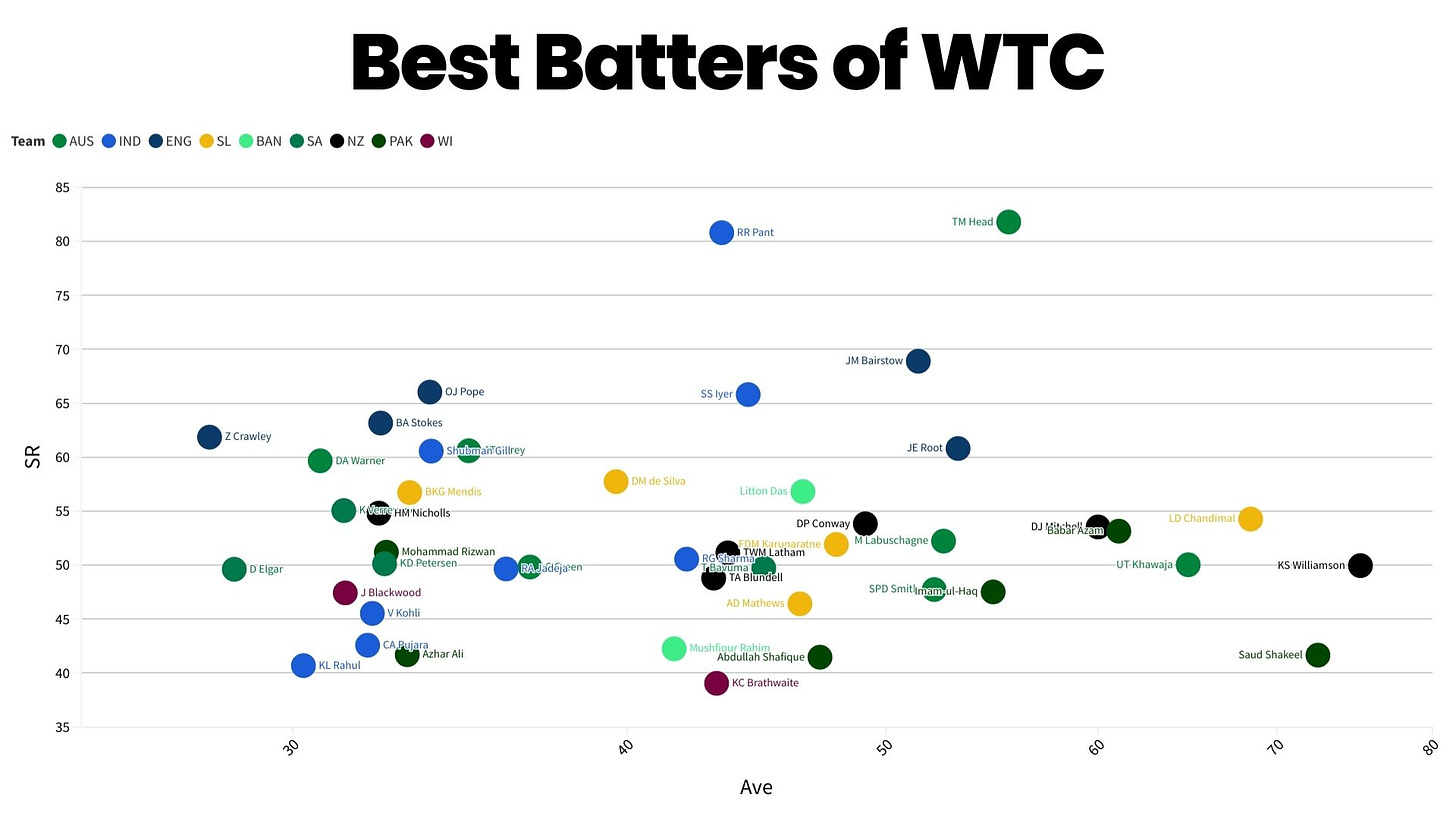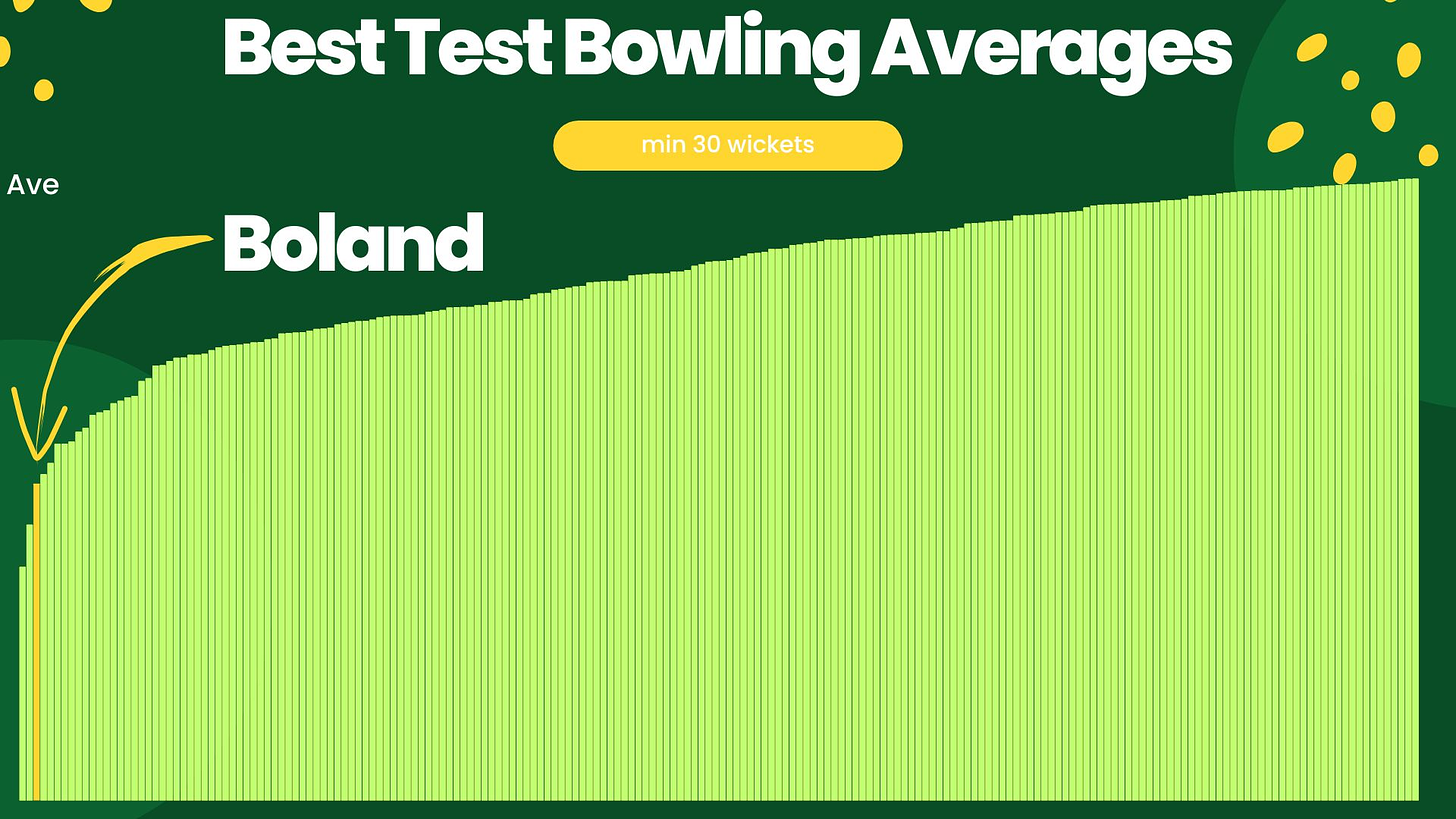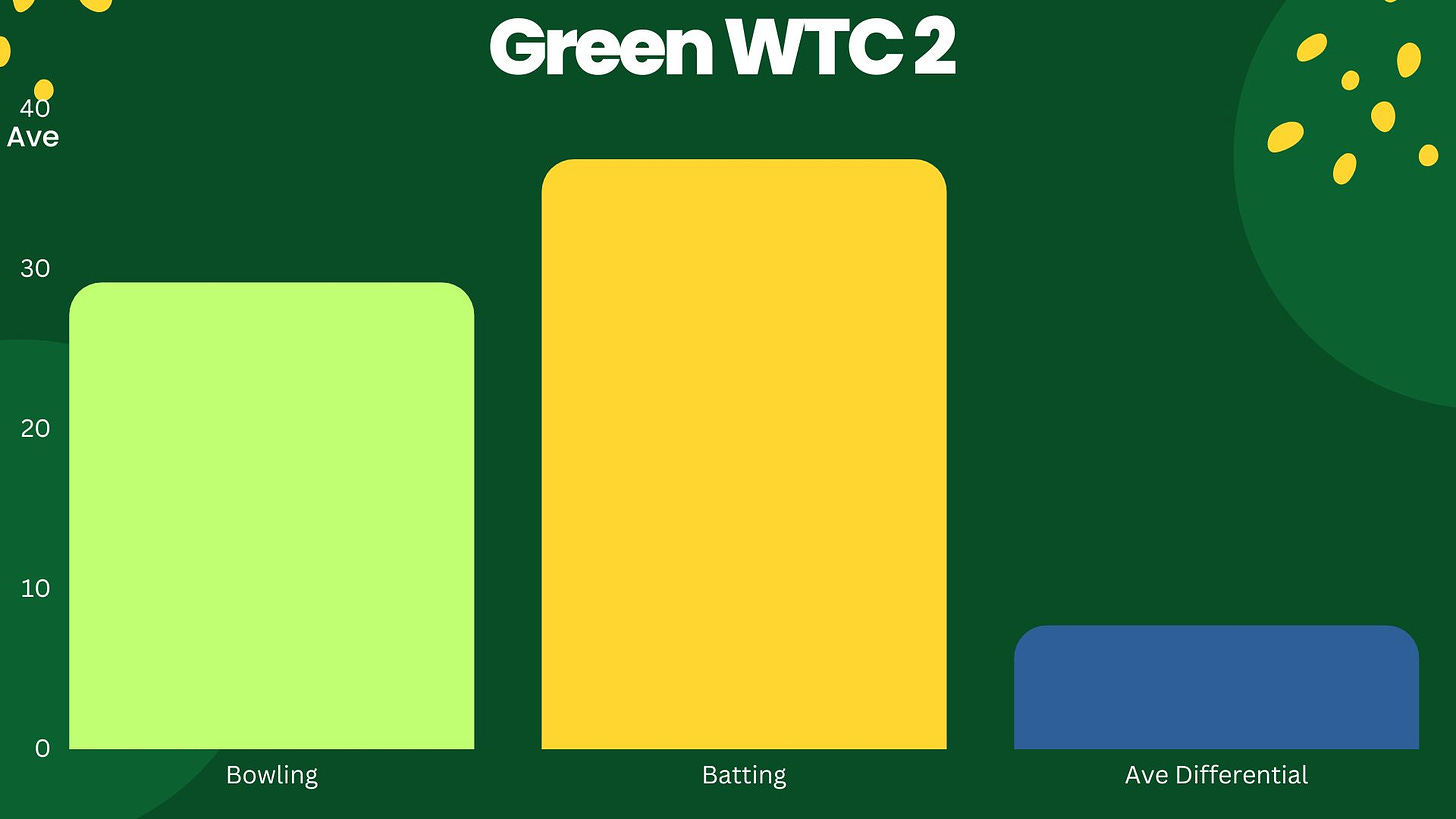Australia now owns the full set of ICC silverware. If you put stars around your logo for every win you have, Australia will start needing bigger shirts.
It took the men until 1987 to win their first ICC big shiny thing. That was the ODI World Cup, played in whites, where England had a real chance until Mike Gatting played a reverse sweep and Australia got off the mark. They have added four more since.
In 2006, they won their first Champions Trophy. Until that point, it was hard to work out if they took it seriously at all. They went back to back on this one as well and ended up wearing white jackets. Still, no one is sure why.
The T20 World Cup they also didn't really fully engage in. When they did, it didn't go all that well. But in 2021, they turned up in UAE with Mitch Marsh as a number three, dropped him, and then reinstated only for him to help them win it all.
And now there is this World Test Championship, winning it on their second try. Oddly, this is the quickest they have conquered an ICC event.
It also means they now have one of everything, like a middle-class dad.
That might depend on how you think about major tournaments because they haven't won a men's Commonwealth gold medal. Shaun Pollock's merry group are still the reigning champs there.
Australia wins at cricket a lot.
However, they did not win last time. In fact, it was slow overstates that ultimately cost them. Though maybe the better way to say that is the points they lose would have been the difference. Before that, there were other issues.
They celebrated hard when retaining the Ashes in England, which was a great achievement. But it was clear watching them that they were not switched on for the final Test. The players have said the same since. It was a two-fold error, they didn't win the Ashes, and then they also let a worse England team steal their WTC points.
The Bangladesh tour was called off due to Australia not wanting to tour during Covid. It depends on how you look at that, of course; Bangladesh were pretty good at home in that period and could have given Australia some trouble. But we'll never know.
The most important one was when they faced the depleted Indian lineup at home. Losing the series was obviously the worst thing. But from a points perspective, getting only a single win and draw out of a home series was a kick in the Adam's apple.
They were good enough to finish an extremely close third and had the same win/loss ratio as New Zealand but two extra draws.
You look at this; they were a top-three team.
The real difference from the first cycle to the second is that New Zealand - and even India - dropped off. Australia improved, but really, the other two were not as good due to injuries and retirements.
Also, let us not discount some good fortune that came to them. Pakistan had a great WTC run and then decided to make wickets at home that were basically impossible to get a result.
And then they double down by playing some pretty poor cricket. Both helped Australia. Not winning a Test gave Australia extra points, and they also ruled themselves out of making it to the final.
A very similar thing happened to England as well. Their form was utterly terrible during the important part of this WTC. Australia played them in five Tests at home. Again, that is the daily double.
Finally, it was India's collapse. By then, Australia's position was looking a little shaky, with Sri Lanka coming from nowhere to try to steal a spot. They ensured they had a chance at the Mace by beating India in that match. Remember why that happened as well. India were clearly the far better team at home, but they made their wickets favour bowlers so much that it reduced it from a game of skill to chance. The Indian batters stuffed up twice, and Australia snuck through the gap.
Australia was probably the better team in this cycle than India, who were not quite as sharp as last time. But India continually played a part. Australia didn't have Hazlewood, India didn't have Bumrah, Pant, Iyer or KL Rahul. The last two are not as important, but you cannot replace players like Bumrah and Pant. In contrast, Australia had a like-for-like mini Josh sitting on the shelf.
India also made an error by not selecting Ashwin against a team of left-handers on a pitch where he has some experience of as a touring pro. He averages 19 at the Oval with ten wickets in first-class cricket. Being that Thakur had a decent game, that is mitigated a little. Of course, Umesh didn't. I get all the issues with why they dropped him, but it's not how I would have set this team up, and when this pitch did flatten out, he would have been very handy.
Maybe what was worse is that India didn't use the new ball that well after ditching the world's best spinner. Also worth noting is that Australia were always at an advantage in English conditions, but even more so when the Oval had this level of pace and carry.
None of this suggests Australia isn't the best team or a deserving champ, but they certainly had a good run in this season.
What they did with that fortune was pretty good. They were the best team with the bat.
Remember, they also played on a couple of fun wickets on their Indian trip. We're used to seeing Australia up high, as historically, it's easier to score runs there. That hasn't been the case over the last couple of years. They earned this mark by being the best batting team in the world.
What about if we throw run rate in there as well?
Obviously, England tops this, even with them only playing half a season of Bazball. But you can see that Australia also scored at a decent clip. They were in complete charge when it came to the bat.
Australia had four batters averaging more than 50 in this cycle.
It's fair to say these four did the heavy lifting. But they also made so many runs that they covered Warner's drop and Green's development. Carey did fine for a keeper, and Green was not terrible for your number six, especially one who can bowl. So it meant that only Warner was under par. If you remember the start of this cycle, Joe Burns was their opener. That's a huge turnaround.
With the ball, they're actually third-best when it comes to average.
But it is about even for those top three; the drop-off behind is pretty big too. Essentially three teams could bowl, and Australia was one of them.
When you bring in the econ, I think India and Australia separate even further.
They did all this with Hazlewood playing four Tests—someone who can help with the economy and average pretty well.
They also had four bowlers with better than 30 averages.
Doing that without Hazlewood is quite an achievement. Starc had a really good cycle, probably better than he gets credit for.
And because this almost never happens, shall we give Nathan Lyon his flowers? I think there was a natural anger at Lyon being called the GOAT, even if it was a bit sarcastic and about Australia having had no offices before him. But almost every year, Lyon is near the top of the wickets table. This cycle, he is not just on top but massively so.
Part of this is because he played so much in Asia, but Lyon always gets wickets and seldom gets injured. He rarely has flashy numbers, but this man buys his wickets in bulk. And knowing you have him means you will get plenty of overs in, decent economy and a collection of wickets throughout the game, not just all at the end.
Average per wicket when factoring in batting averages subtracted from your bowling is very good to this team as well. There were four positive teams in terms of this, but really there was India, with a healthy five-run buffer of making runs compared to allowing them.
Then there is Australia, who were more than twice as good as the second-best team. That is about as dramatic a difference as you can find.
And those numbers hold up pretty well when you look at their win-loss ratio. You can argue they had some luck in the regular season games and the final itself. I don't think you can mount a case they weren't the best team in this cycle.
They were better because so many players you wouldn't expect or just didn't know, stood up.
It is possible that before he was picked for Australia, Todd Murphy didn't exist. He didn't have a huge impact on this win, but he certainly played his part when he arrived in India looking like a social media intern. That he did so well was not usually how young Aussie spinners go on debut in India. Strong, not since Lyon vibes.
I don't know what comeback number Usman is on now. It has been an awfully long journey, and while he didn't do much in this final, he has been pretty much opening the batting from both ends to cover for Warner in this cycle.
I was there when he made 37, and the world went crazy.
That was so long ago there is a chance retirement is not far off for him. But even for a player known to go on a run, this was probably the best we had seen of him. To be the best batter over this period from starting outside the team is some effort.
And the second best was Head. Those two starring with Marnus continuing to make runs and Smith bouncing back was so huge.
However, for Head, this must feel massive; a player of the match in the final of a series, it wasn't that long ago he was out of the same for being frail. Head had massive issues in Asia and England, and in the space of a few Tests, he seems to have a least improved, and chances are he feels like he's conquered it.
His real importance to Australia is not just the amount of runs but the speed of them. With Warner slowing down and Carey more of a cameo guy, Head has been the chief enforcer.
Only Rishabh Pant has the kind of impact Head can. Obviously, next cycle, they'll probably have a few English friends up here. But Head's ability to change the game's conversation was useful this season.
I will eventually stop showing this graphic.
But only when Scott Boland isn't the greatest anomaly we've had since Mike Hussey.
Because how can I not show that Boland still has the third-best bowling average in the history of our sport, minimum of 30 wickets, of course? It's stupid.
He's obviously not the third-best ever. But think of what he is for Australia right now; he's certainly their third-best bowler. So with Hazlewood out, this 32-year-old first-class seamer became a destroyer of worlds.
And lastly - coming straight out of the giant WA all-rounder factory - we have Cameron Green. On the face of it, his numbers are just ok. But worth taking one slightly better look at the fact was worth almost eight runs on average differential.
I still think there is plenty of work to be done on his batting and bowling. However, would Australia take a career of 36 batting average and 29 bowling average on decent usage? Without hesitation.
Even this development version of Green changed the Australian team. Australia had balance for the first time since Watto's hamstring went tight. They still dream of Green being Keith Miller MK II. But any team with Cummins's skill and Lyon's wickets is so much more potent with a fifth option.
Just think of those players for a moment. An offie seven people had heard of, two batters that were out of the team or dropped, a seamer they ignored for a decade and a rounder they had almost given up looking for. That is not mentioning Cummins, Smith, Warner and Starc.
This was a good team last cycle, and in this one, almost everything they tried worked. They're a Josh Hazlewood clean bill of health away from about the perfect two years.
Australia's biggest issue is buying a larger trophy case. They own nine ICC men's titles. If you include the women, there are another 13. I don't have numbers on the disability teams, but probably a few more there.
No matter how you look at it, Australia in cricket is the winningest nation of winners to ever win. Death, taxes, Australia winning a trophy. A-Mace-ing.




